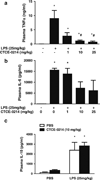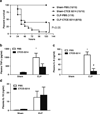Beneficial effect of a CXCR4 agonist in murine models of systemic inflammation
- PMID: 21274742
- PMCID: PMC3612970
- DOI: 10.1007/s10753-011-9297-5
Beneficial effect of a CXCR4 agonist in murine models of systemic inflammation
Abstract
The chemokine CXC receptor 4 (CXCR4) is activated by stromal cell-derived factor (SDF-1α). CXCR4 may be part of a lipopolysaccharide (LPS) sensing co-clustering complex that modulates TLR4 activation and evidence suggest that SDF-1α can activate anti-inflammatory signaling pathways and suppress inflammation. In the present study we examined the hypothesis that the SDF-1α peptide analog and CXCR4 agonist CTCE-0214 is anti-inflammatory in three distinct models of murine systemic inflammation. Our findings demonstrate that CTCE-0214 in vivo significantly suppressed plasma tumor necrosis factor alpha (TNF-α) increases in acute endotoxemia and following zymosan-induced multiple organ dysfunction syndrome (MODS). In both models, CTCE-0214 did not suppress plasma increases in the anti-inflammatory cytokine interleukin (IL)-10. CTCE-0214 improved survival without antibiotics in a model of severe sepsis induced by cecal ligation and puncture (CLP). CTCE-0214 also decreased plasma increases in IL-6 but not TNF-α and IL-10 in response to CLP-induced inflammation. We demonstrated in a moderately severe model of CLP (one puncture) that IL-6 levels at 24 h were similar to sham controls. However in severe CLP (two punctures) plasma IL-6 levels were markedly elevated. Plasma SDF-1α levels varied inversely with the plasma IL-6. In addition to the beneficial effect of CTCE-0214 in these models of systemic inflammation in vivo, we also demonstrated that the analog dose dependently suppressed LPS-induced IL-6 production in bone marrow-derived macrophages. CTCE-0214 therefore may be beneficial in controlling inflammation sepsis and systemic inflammatory syndromes.
Figures






Similar articles
-
Administration of a CXCL12 Analog in Endotoxemia Is Associated with Anti-Inflammatory, Anti-Oxidative and Cytoprotective Effects In Vivo.PLoS One. 2015 Sep 16;10(9):e0138389. doi: 10.1371/journal.pone.0138389. eCollection 2015. PLoS One. 2015. PMID: 26375818 Free PMC article.
-
Endothelial progenitor cells and a stromal cell-derived factor-1α analogue synergistically improve survival in sepsis.Am J Respir Crit Care Med. 2014 Jun 15;189(12):1509-19. doi: 10.1164/rccm.201312-2163OC. Am J Respir Crit Care Med. 2014. PMID: 24707934 Free PMC article.
-
The CXCR4 agonist peptide, CTCE-0021, rapidly mobilizes polymorphonuclear neutrophils and hematopoietic progenitor cells into peripheral blood and synergizes with granulocyte colony-stimulating factor.Exp Hematol. 2005 Mar;33(3):295-307. doi: 10.1016/j.exphem.2004.11.008. Exp Hematol. 2005. PMID: 15730853
-
Is circulating endotoxin the trigger for the systemic inflammatory response syndrome seen after injury?Ann Surg. 1997 May;225(5):530-41; discussion 541-3. doi: 10.1097/00000658-199705000-00010. Ann Surg. 1997. PMID: 9193181 Free PMC article.
-
The involvement of a chemokine receptor antagonist CTCE-9908 and kynurenine metabolites in cancer development.Cell Biochem Funct. 2022 Aug;40(6):608-622. doi: 10.1002/cbf.3731. Epub 2022 Jul 5. Cell Biochem Funct. 2022. PMID: 35789495 Review.
Cited by
-
Regulation of Airway Inflammation by G-protein Regulatory Motif Peptides of AGS3 protein.Sci Rep. 2016 Jun 7;6:27054. doi: 10.1038/srep27054. Sci Rep. 2016. PMID: 27270970 Free PMC article.
-
Pharmacological targeting of chemokine (C-X-C motif) receptor 4 in porcine polytrauma and hemorrhage models.J Trauma Acute Care Surg. 2016 Jan;80(1):102-10. doi: 10.1097/TA.0000000000000865. J Trauma Acute Care Surg. 2016. PMID: 26683396 Free PMC article.
-
Study of the Effect of Wild-Type and Transiently Expressing CXCR4 and IL-10 Mesenchymal Stromal Cells in a Mouse Model of Peritonitis.Int J Mol Sci. 2023 Dec 30;25(1):520. doi: 10.3390/ijms25010520. Int J Mol Sci. 2023. PMID: 38203690 Free PMC article.
-
Molecular mechanism of miRNA-23a in sepsis-induced lung injury.Am J Transl Res. 2023 Jun 15;15(6):3900-3911. eCollection 2023. Am J Transl Res. 2023. PMID: 37434814 Free PMC article.
-
Stromal-derived factor-1 and its receptor, CXCR4, are constitutively expressed by mouse liver sinusoidal endothelial cells: implications for the regulation of hematopoietic cell migration to the liver during extramedullary hematopoiesis.Stem Cells Dev. 2012 Aug 10;21(12):2142-51. doi: 10.1089/scd.2011.0565. Epub 2012 Jan 26. Stem Cells Dev. 2012. PMID: 22121892 Free PMC article.
References
-
- Akira S, Uematsu S, Takeuchi O. Pathogen recognition and innate immunity. Cell. 2006;124:783–801. - PubMed
-
- Akashi S, Shimazu R, Ogata H, Nagai Y, Takeda K, Kimoto M, Miyake K. Cutting edge: Cell surface expression and lipopolysaccharide signaling via the toll-like receptor 4-MD-2 complex on mouse peritoneal macrophages. Journal of Immunology. 2000;164:3471–3475. - PubMed
-
- Triantafilou K, Triantafilou M, Dedrick RL. A CD14-independent LPS receptor cluster. Nature Immunology. 2001;2:338–345. - PubMed
-
- Akira S, Takeda K. Toll-like receptor signalling. Nature Reviews. Immunology. 2004;4:499–511. - PubMed
-
- Triantafilou M, Lepper PM, Briault CD, Ahmed MA, Dmochowski JM, Schumann C, Triantafilou K. Chemokine receptor 4 (CXCR4) is part of the lipopolysaccharide "sensing apparatus". European Journal of Immunology. 2008;38:192–203. - PubMed
Publication types
MeSH terms
Substances
Grants and funding
LinkOut - more resources
Full Text Sources
Miscellaneous

